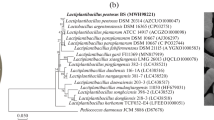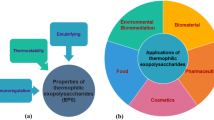Abstract
Exopolysaccharides or extracellular polymeric substances (EPS) has become an important resource and is being increasingly used in the biotechnology and biopharmaceutical industries. However, its production from glycerol under thermophilic conditions has not been reported. This study is aimed at isolating high-performance, EPS-producing bacteria under thermophilic conditions using glycerol as the substrate. Among the isolated microorganisms, Bacillus sonorensis strain NTV10 exhibited the highest EPS production. The optimum cultivation conditions in the enrichment medium (HS medium) were 1 g/L glycerol, 45 °C, and pH 7, with the highest EPS production of 15.97 mg/mL. We confirmed that NTV10 prefers thermophilic conditions for the highest EPS production. However, the utilization of glycerol was low because of the presence of yeast extracts and peptone in the HS medium. Therefore, the ability of glycerol conversion into EPS by NTV10 was evaluated using minimal medium (medium E*). We found that 15 g/L glycerol exhibited the highest EPS production (8.8 mg/mL). The monosaccharide composition of EPS from both media was similar, containing glucose, mannose, and rhamnose in a relative ratio of 5.1:2.2:1. The results of the IR spectrum showed the presence of mainly carboxyl and hydroxyl groups in the EPS product, which was in accordance with the monosaccharide composition. These properties can be applied in various industries such as food processing, cosmetics, and pharmaceuticals. The experimental knowledge derived from this study can be used to promote the use of glycerol as a renewable substrate for bioconversion into highly valuable products, such as EPS production.





Similar content being viewed by others
Data availability
All data generated or analyzed during this study are included in this published article (and its supplementary information files).
References
Duque A, Álvarez C, Doménech P, Manzanares P, Moreno AD (2021) Advanced bioethanol production: from novel raw materials to integrated biorefineries. Processes 9:206. https://doi.org/10.3390/pr9020206
Yang F, Hanna MA, Sun R (2012) Value-added uses for crude glycerol–a byproduct of biodiesel production. Biotechnol Biofuels 5:13. https://doi.org/10.1186/1754-6834-5-13
Hejna A, Kosmela P, Formela K, Piszczyk Ł, Haponiuk JT (2016) Potential applications of crude glycerol in polymer technology–current state and perspectives. Renew Sustain Energy Rev 66:449–475. https://doi.org/10.1016/j.rser.2016.08.020
Yazdani SS, Gonzalez R (2007) Anaerobic fermentation of glycerol: a path to economic viability for the biofuels industry. Curr Opin Biotechnol 18:213–219. https://doi.org/10.1016/j.copbio.2007.05.002
Nicol RW, Marchand K, Lubitz WD (2012) Bioconversion of crude glycerol by fungi. Appl Microbiol Biotechnol 93:1865–1875. https://doi.org/10.1007/s00253-012-3921-7
Nwachukwu R, Shahbazi A, Wang L, Ibrahim S, Worku M, Schimmel K (2012) Bioconversion of glycerol to ethanol by a mutant Enterobacter aerogenes. AMB Express 2:20. https://doi.org/10.1186/2191-0855-2-20
Nicolaus B, Kambourova M, Oner ET (2010) Exopolysaccharides from extremophiles: from fundamentals to biotechnology. Environ Technol 31:1145–1158. https://doi.org/10.1080/09593330903552094
Andhare P, Chauhan K, Dave M, Pathak H (2014) Microbial exopolysaccharides: advances in applications and future prospects. In: Tewari R (ed) Biotechnology volume 3: microbial biotechnology, 1st edn. Studium Press LLC, pp 25. https://doi.org/10.13140/RG.2.1.3518.4484
Torino MI, H ébert EM, Mozzi F, Font de Valdez G, (2005) Growth and exopolysaccharide production by Lactobacillus helveticus ATCC 15807 in an adenine-supplemented chemically defined medium. J Appl Microbiol 99:1123–1129. https://doi.org/10.1111/j.1365-2672.2005.02701.x
Torres CA, Marques R, Ferreira AR, Antunes S, Grandfils C, Freitas F, Reis MA (2014) Impact of glycerol and nitrogen concentration on Enterobacter A47 growth and exopolysaccharide production. Int J Biol Macromol 71:81–86. https://doi.org/10.1016/j.ijbiomac.2014.04.012
Jalili Tabaii M, Emtiazi G (2015) Comparison of bacterial cellulose production among different strains and fermented media. Appl Food Biotechnol 3:35–41. https://doi.org/10.22037/afb.v3i1.10582
Jonas R, Farah LF (1998) Production and application of microbial cellulose. Polym Degrad Stab 59:101–106. https://doi.org/10.1016/S0141-3910(97)00197-3
Panthavee W, Noda M, Danshiitsoodol N, Kumagai T, Sugiyama M (2017) Characterization of exopolysaccharides produced by thermophilic lactic acid bacteria isolated from tropical fruits of Thailand. Biol Pharm Bull 40:621–629. https://doi.org/10.1248/bpb.b16-00856
Jachlewski S, Jachlewski WD, Linne U, Bräsen C, Wingender J, Siebers B (2015) Isolation of extracellular polymeric substances from biofilms of the thermoacidophilic archaeon Sulfolobus acidocaldarius. Front Bioeng Biotechnol 3:123. https://doi.org/10.3389/fbioe.2015.00123
Sardari RR, Kulcinskaja E, Ron EY, Björnsdóttir S, Friðjónsson ÓH, Hreggviðsson GÓ, Karlsson EN (2017) Evaluation of the production of exopolysaccharides by two strains of the thermophilic bacterium Rhodothermus marinus. Carbohydr Polym 156:1–8. https://doi.org/10.1016/j.carbpol.2016.08.062
Gebreeyessus GD, Jenicek P (2016) Thermophilic versus mesophilic anaerobic digestion of sewage sludge: a comparative review. Bioengineering 3:15. https://doi.org/10.3390/bioengineering3020015
Nakasaki K, Hirai H (2017) Temperature control strategy to enhance the activity of yeast inoculated into compost raw material for accelerated composting. Waste Manag 65:29–36. https://doi.org/10.1016/j.wasman.2017.04.019
Ua-Arak T, Jakob F, Vogel RF (2016) Characterization of growth and exopolysaccharide production of selected acetic acid bacteria in buckwheat sourdoughs. Int J Food Microbiol 19(239):103–112. https://doi.org/10.1016/j.ijfoodmicro.2016.04.009
Hestrin S, Schramm M (1954) Synthesis of cellulose by Acetobacter xylinum. II. Preparation of freeze-dried cells capable of polymerizing glucose to cellulose. Biochem J 58:345–352. https://doi.org/10.1042/bj0580345
DuBois M, Gilles KA, Hamilton JK, Rebers PA, Smith F (1956) Colorimetric method for determination of sugars and related substances. Anal Chem 28:350–356. https://doi.org/10.1021/ac60111a017
Brandl H, Gross RA, Lenz RW, Fuller RC (1988) Pseudomonas oleovorans as a source of poly(beta-hydroxyalkanoates) for potential applications as biodegradable polyesters. Appl Environ Microbiol 54:1977–1982. https://doi.org/10.1128/aem.54.8.1977-1982.1988
Palmisano MM, Nakamura LK, Duncan KE, Istock CA, Cohan FM (2001) Bacillus sonorensis sp. nov., a close relative of Bacillus licheniformis, isolated from soil in the Sonoran Desert. Arizona Int J Syst Evol Microbiol 51:1671–1679. https://doi.org/10.1099/00207713-51-5-1671
Palaniyandi S, Damodharan K, Suh JW, Yang SH (2018) Functional characterization of an exopolysaccharide produced by Bacillus sonorensis MJM60135 isolated from Ganjang. J Microbiol Biotechnol 28:663–670. https://doi.org/10.4014/jmb.1711.11040
Freitas F, Alves VD, Pais J, Carvalheira M, Costa N, Oliveira R, Reis MAM (2010) Production of a new exopolysaccharide (EPS) by Pseudomonas oleovorans NRRL B-14682 grown on glycerol. Process Biochem 45:297–305. https://doi.org/10.1016/j.procbio.2009.09.020
Spanò A, Gugliandolo C, Lentini V, Maugeri TL, Anzelmo G, Poli A, Nicolaus B (2013) A novel EPS-producing strain of Bacillus licheniformis isolated from a shallow vent off Panarea Island (Italy). Curr Microbiol 67:21–29. https://doi.org/10.1007/s00284-013-0327-4
Moghannem SAM, Farag MMS, Shehab AM, Azab MS (2018) Exopolysaccharide production from Bacillus velezensis KY471306 using statistical experimental design. Braz J Microbiol 49:452–462. https://doi.org/10.1016/j.bjm.2017.05.012
Gorret N, Maubois JL, Engasser JM, Ghoul M (2001) Study of the effects of temperature, pH and yeast extract on growth and exopolysaccharides production by Propionibacterium acidi-propionici on milk microfiltrate using a response surface methodology. J Appl Microbiol 90:788–796. https://doi.org/10.1046/j.1365-2672.2001.01310.x
Moghannem SAM, Farag MMS, Shehab AM, Azab MS (2017) Media optimization for exopolysaccharide producing Klebsiella oxytoca KY498625 under varying cultural condition. Int J Adv Res Biol Sci 4:16–30. https://doi.org/10.22192/ijarbs.2017.04.03.002
Wei Z, Huang S, Zhang Y, Li H, Zhou S (2017) Characterization of extracellular polymeric substances produced during nitrate removal by a thermophilic bacterium Chelatococcus daeguensis TAD1 in batch cultures. RSC Adv 7:44265–44271. https://doi.org/10.1039/C7RA08147B
Kimmel SA, Roberts RF, Ziegler GR (1998) Optimization of exopolysaccharide production by Lactobacillus delbrueckii subsp. bulgaricus RR grown in a semidefined medium. Appl Environ Microbiol 64:659–664. https://doi.org/10.1128/AEM.64.2.659-664.1998
Song YR, Song NE, Kim JH, Nho YC, Baik SH (2011) Exopolysaccharide produced by Bacillus licheniformis strains isolated from Kimchi. J Gen Appl Microbiol 57:169–175. https://doi.org/10.2323/jgam.57.169
Agunbiade MO, Van Heerden E, Pohl CH, Ashafa AT (2017) Flocculating performance of a bioflocculant produced by Arthrobacter humicola in sewage wastewater treatment. BMC Biotechnol 17:51. https://doi.org/10.1186/s12896-017-0375-0
Jeong JP, Kim Y, Hu Y, Jung S (2022) Bacterial succinoglycans: structure, physical properties, and applications. Polymers (Basel) 14:276. https://doi.org/10.3390/polym14020276
Freitas F, Alves VD, Reis MA (2011) Advances in bacterial exopolysaccharides: from production to biotechnological applications. Trends Biotechnol 29:388–398. https://doi.org/10.1016/j.tibtech.2011.03.008
Acknowledgements
The authors would like to thank Assoc. Prof. Dr. Manabu Fujii, Department of Civil and Environmental Engineering, Tokyo Institute of Technology, for aiding in the use of the freeze-dryer. Moreover, the authors would also like to thank Prof. Dr. Masaki Kawano, Department of Chemistry, Tokyo Institute of Technology, for helping with the FTIR analysis.
Funding
This work received support from the Japan Society for the Promotion of Science (JSPS), JSPS Postdoctoral Fellowships (grant number: P17354).
Author information
Authors and Affiliations
Contributions
All authors contributed to the study conception and design. Material preparation, data collection, and analysis were performed by Nunthaphan Vikromvarasiri. The first draft of the manuscript was written by Nunthaphan Vikromvarasiri. Supervision was done by Kiyohiko Nakasaki. All authors read, revised, and approved the final manuscript.
Corresponding author
Ethics declarations
Ethical approval
Not applicable.
Competing interests
The authors declare no competing interests.
Additional information
Publisher's note
Springer Nature remains neutral with regard to jurisdictional claims in published maps and institutional affiliations.
Supplementary Information
Below is the link to the electronic supplementary material.
Rights and permissions
Springer Nature or its licensor (e.g. a society or other partner) holds exclusive rights to this article under a publishing agreement with the author(s) or other rightsholder(s); author self-archiving of the accepted manuscript version of this article is solely governed by the terms of such publishing agreement and applicable law.
About this article
Cite this article
Vikromvarasiri, N., Nakasaki, K. Exopolysaccharide production from glycerol by Bacillus sonorensis NTV10 under thermophilic condition. Biomass Conv. Bioref. (2023). https://doi.org/10.1007/s13399-023-04402-7
Received:
Revised:
Accepted:
Published:
DOI: https://doi.org/10.1007/s13399-023-04402-7




